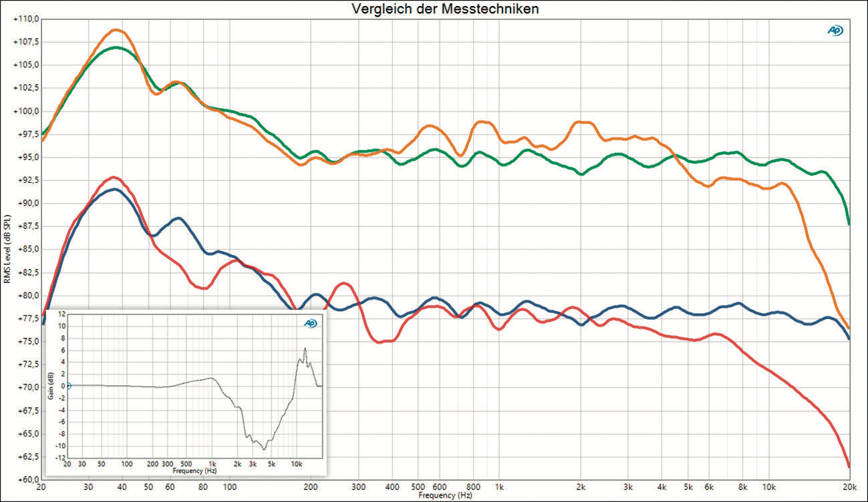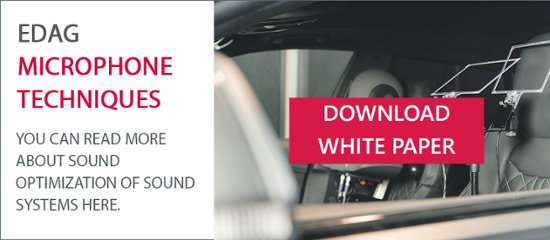Having a high quality sound system in the car is not necessarily a guarantee for a good sound. The characteristics of the speakers, their installation in the vehicle and their directivity are just some of the variables that can affect the listening experience. Suitable measurement technology renders a useful service on the path to perfect sound tuning. There are different options here, each differing in its application.
There are a number of options available to someone wanting to enjoy some music on his or her way to a customer or on the way home. DAB radio, Internet streaming services or personal playlists on smartphones – as a general rule, digital transmission is both undisrupted and high-resolution. But what actually gets through to the ears in the end is another story altogether.
The basic framework of a sound system consists of an amplifier and loudspeakers. Only through microprocessor-controlled signal processing, however, do the individual sound sources in the vehicle create a coordinated overall system capable of clearly and faithfully reproducing music, podcasts, telephone calls and announcements from driver assistance systems. And yet, processing the signal to achieve the best possible result is a challenging task in sound system development. Various ways of carrying out measuring technology-based sound tuning in the vehicle are presented in the following.
General basic conditions
A system with 14 loudspeakers and one amplifier – a typical setup from the premium sector – served as the starting point for the following observations. 3-way systems consisting of a woofer and a mid-range speaker in the doors and tweeters in the A-pillars or instrument panels are often installed in the front end. The subwoofer is generally located in the trunk.
A glance at the exact installation positions of the sound transducers immediately uncovers a number of problem areas. The seating position is not in the middle of the vehicle, for example, and therefore not ideal from an acoustic point of view. A center speaker in the dashboard can give both the driver and the passenger decent stage presentation, i.e. a good placement of the instruments and the vocals can be achieved.
Often, no use is made of mid-range speakers in the rear doors. The mid-range speaker installed (if used), and especially the tweeter, is much closer to the driver or passenger than to the passengers in the rear. This means that without sound tuning, these speakers are too clearly audible to anyone seated in the front. The requirements vary greatly from vehicle to vehicle and according to speaker configuration, depending, for instance, on the directivity of a tweeter. To a certain extent, correct alignment can enable the level differences between the left- and right-hand tweeter to be adjusted.
The design and adjustment of high-end systems with 30 or even 40 speakers are even more complex and time-consuming. They do, however, enable even more faithful reproduction of 3D sound and other algorithms.
Measuring technology-based sound tuning
The basis for signal processing to optimize the sound is data about the sound propagation in the vehicle cabin. In the development phase, for example, this includes detailed speaker measurements, including directional diagrams and 3D balloon data. Later in the process, the frequency-amplitude curves of the individual loudspeaker groups and the overall frequency response, i.e. the sum of all sound sources, measured on the driver's seat, are also extremely important. The curves measured in the vehicle no longer correspond in any way with the data from the development phase, measured in the free field, without noticeable reflection, on axis, and at a distance of one meter.
There are different ways of measuring the individual speakers/speaker groups in the vehicle:
- a single microphone,
- a dummy head system, or
- microphone arrays consisting of several microphones.
Each measuring method has its advantages and disadvantages. Either noise signals (pink or white noise) or logarithmic sinus sweeps are used as measuring signals. The impulse responses recorded by the microphones are broken down into short sections by means of fast Fourier transformation (FFT), and converted into the frequency domain.
Where measurements are made using a single microphone, reproducible results can be obtained by playing a noise signal while slowly moving the microphone around the face. During the measurement period of approx. 10 to 15 seconds, a large amount of data is collected and can, for example, be averaged over time using a real time analyzer (RTA). Stationary use of a single microphone on the other hand is not recommended for frequency response analysis. Above approx. 300 Hz, small changes in position lead to very different results.
Dummy heads are always used whenever psychoacoustics plays an important role. This deals with the way in which noises and sounds are discerned and perceived. In NVH (noise, vibration, harshness) departments, for instance, disturbing noises caused by vibrations are recorded and then analyzed. If a normal microphone recording is to be simulated, the dummy head recording must be HRTF (head related transfer function) equalized. This involves adjusting the sound reflections and diffractions occurring in the head and shoulder area, e.g. the amplification level in around the 4 kHz range (λ/4 resonance of the auditory canal). The great advantage of this recording technology is that the directional information is displayed very well when played back using headphones that have also been equalized. To a certain degree, the system installed in the vehicle can also be listened to and evaluated at the desk.
The third possibility are microphone arrays consisting of six or more microphones to cover a larger recording area with a single measurement. The individual measurement curves are averaged here, which means that the large differences in the individual measurements above approx. 300 Hz are smoothed out. This measurement is therefore already well adapted to the auditory resolving power of the human ear. In order to obtain data about the entire sound field in the vehicle at one and the same time, several arrays are positioned on the different seats. This is very important if the sound is to be optimized for all the occupants of the vehicle at the same time, since each of the acoustic sources in the vehicle influences the others.
Conclusion
No matter whether for a sound system with 14 loudspeakers in a small car or a 40-channel system in a large SUV, acoustic measuring technology helps to answer many questions, for instance:
- Is the ratio of low to high frequencies correct?
- Does the sound from the individual speakers reach the ear at the right time?
- Do higher volumes produce distortion?
Tuning based on a frequency response target curve provides a very good basis for all further details. From a purely technical point of view, a good result can be achieved by means of suitable level ratios and running times between the individual speakers. In the professional environment, this kind of tuning offers further advantages. The systems can be measured while they are still on the production line, and verified using the tuning measurement curves. What is more, the curves and single values always form the basis for (partially) automated but also virtual sound tuning – even if the human factor is still indispensable when it comes to final fine tuning.
How to obtain meaningful simulation and measurement data, interpret this correctly and then draw the appropriate conclusions is something Thomas Baumgartner, technical expert in the EDAG Group's Sound & Acoustics department, knows all about. He will be happy to answer your questions on the measuring technology-based sound optimization of sound systems in vehicle construction. More details of our measuring processes and the resulting findings can be found in our white paper "Optimal Sound Experience on Four Wheels", which can be downloaded here.






